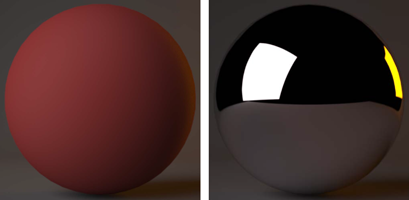...
| Section | |||||||||
|---|---|---|---|---|---|---|---|---|---|
|
A surface which scatters almost all light in a chaotic, diffuse way is called a "lambertian" surface, such as the red ball below (F. 01). Lambertian reflectance means that light falling on a surface is scattered in such a way that the apparent brightness of the surface is the same, regardless of the observer's angle of view. Or else: the surface's luminance is the same regardless of angle of view. Many rough surfaces, such as unfinished wood, exhibit lambertian reflectancesmooth surface however reflects light uniformly and creates a very sharp or specular reflection of its environment. Specular reflection is the perfect, mirror-like reflection of light from a surface, in which light from a single incoming direction is reflected into a single outgoing reflection, as for example with a mirror.
It is important to note that because very smooth surfaces reflect light perfectly, they reflect much less of their own color. This is visible in the render (See above F.02)example above, where the ball is still tinted red, but as it is a tinted mirror, its own color shows much less. There are a few exceptions however and one of them is metals. Even if a metal is very smooth, it still reflects its own color much more.
...
